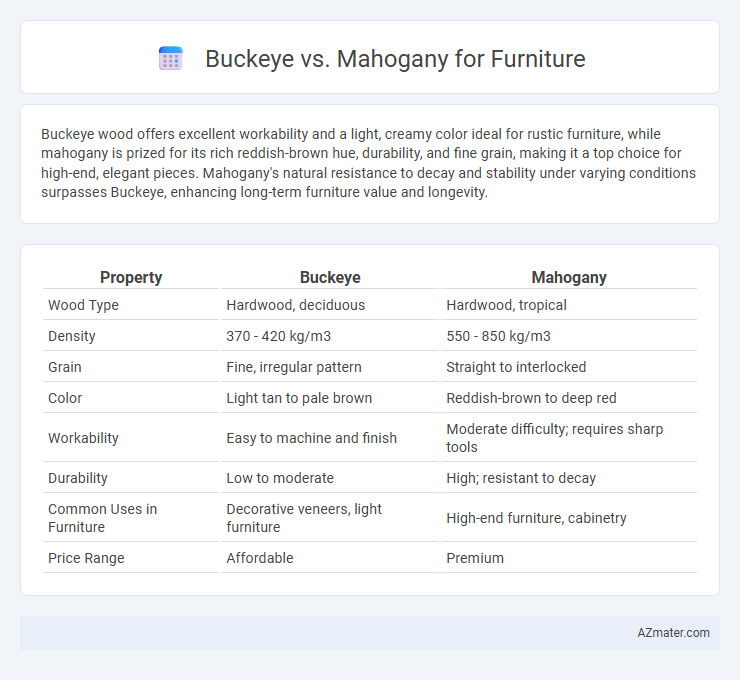Buckeye wood offers excellent workability and a light, creamy color ideal for rustic furniture, while mahogany is prized for its rich reddish-brown hue, durability, and fine grain, making it a top choice for high-end, elegant pieces. Mahogany's natural resistance to decay and stability under varying conditions surpasses Buckeye, enhancing long-term furniture value and longevity.
Table of Comparison
| Property | Buckeye | Mahogany |
|---|---|---|
| Wood Type | Hardwood, deciduous | Hardwood, tropical |
| Density | 370 - 420 kg/m3 | 550 - 850 kg/m3 |
| Grain | Fine, irregular pattern | Straight to interlocked |
| Color | Light tan to pale brown | Reddish-brown to deep red |
| Workability | Easy to machine and finish | Moderate difficulty; requires sharp tools |
| Durability | Low to moderate | High; resistant to decay |
| Common Uses in Furniture | Decorative veneers, light furniture | High-end furniture, cabinetry |
| Price Range | Affordable | Premium |
Overview: Buckeye vs Mahogany in Furniture Making
Buckeye wood is lightweight and soft, making it easier to carve but less durable for heavy-use furniture, whereas mahogany is a dense hardwood known for its strength, durability, and rich reddish-brown color, ideal for high-quality, long-lasting furniture pieces. Buckeye's pale, creamy appearance suits rustic or decorative projects but lacks the natural resistance to wear and moisture that mahogany provides, which enhances the latter's appeal in fine furniture and cabinetry. Mahogany's fine grain and stability also allow intricate detailing and smooth finishes that are harder to achieve with the more porous and softer Buckeye wood.
Botanical Origins and Growth Habits
Buckeye wood originates from the Aesculus genus, predominantly found in North America, and is known for its lightweight and soft texture, making it suitable for decorative furniture pieces. Mahogany, derived from the Swietenia genus native to Central and South America, is prized for its dense, durable hardwood and rich reddish-brown color, often used in high-quality, long-lasting furniture. Growth habits differ significantly as Buckeye trees grow relatively quickly with broad leaves, while Mahogany trees develop slowly, producing tall, straight trunks ideal for large furniture components.
Appearance and Color Characteristics
Buckeye wood features a light, creamy color with subtle brown streaks and a fine, consistent grain, offering a sleek and modern appearance for furniture. Mahogany showcases a rich, reddish-brown hue that deepens over time, complemented by a straight, fine-grained texture that provides a classic, luxurious aesthetic. The distinct color saturation and grain patterns in mahogany create a warm ambiance, while buckeye's lighter tones suit contemporary and minimalist designs.
Durability and Longevity Comparison
Buckeye wood offers moderate durability with a Janka hardness rating around 520, making it softer and less resistant to dents compared to Mahogany, which features a higher Janka hardness of approximately 900 to 1,100. Mahogany's dense grain structure provides superior resistance to decay, warping, and insect damage, contributing to its renowned longevity in furniture applications. While Buckeye may be suitable for decorative pieces, Mahogany stands out for long-lasting, durable furniture favored in heirloom-quality and outdoor settings.
Workability and Ease of Crafting
Buckeye wood offers exceptional workability due to its lightweight nature and softness, making it easy to cut, carve, and shape for intricate furniture designs. Mahogany is prized for its smooth texture and stability, allowing craftsmen to achieve fine finishes with less effort while maintaining durability. Both woods are favored for furniture, but Buckeye is often preferred for detailed carving, whereas Mahogany excels in straightforward woodworking and sanding processes.
Cost and Market Availability
Buckeye wood is generally more affordable than mahogany due to its abundant supply and fast growth rate, making it a cost-effective option for furniture production. Mahogany, prized for its rich color and durability, commands a higher price because of its limited availability and slower growth. Market availability favors Buckeye in most regions, whereas genuine mahogany is often sourced from specific tropical areas, which can lead to scarcity and increased costs.
Environmental Impact and Sustainability
Buckeye wood, sourced primarily from North American regions, is often harvested as a byproduct of wildlife management, minimizing deforestation effects and promoting ecological balance. Mahogany, especially when not certified by the Forest Stewardship Council (FSC), faces criticism for contributing to illegal logging and habitat destruction in tropical rainforests. Choosing sustainably harvested Buckeye supports reduced environmental footprints, while responsible Mahogany use requires verifying sustainable sourcing and certification to ensure preservation of biodiversity and forest ecosystems.
Popular Uses in Furniture Design
Buckeye wood, prized for its lightweight and smooth texture, is commonly used in crafting intricate furniture details such as inlays and turned elements, while mahogany is favored for its rich color, durability, and fine grain, making it ideal for high-end cabinetry and classic furniture frames. The natural resistance of mahogany to decay and warping contributes to its popularity in outdoor and heirloom furniture pieces, whereas buckeye's softness limits its use to primarily decorative or light-duty furniture components. Both woods cater to different design aesthetics, with mahogany often associated with traditional, luxurious styles and buckeye appealing to artisans seeking unique textures and lighter tones.
Maintenance and Care Requirements
Buckeye wood requires regular sealing and occasional oiling to prevent moisture damage and maintain its rich color, while mahogany is more naturally resistant to moisture and insects, needing less frequent upkeep. Both woods benefit from dusting with a soft cloth and avoiding harsh chemicals to preserve their finish and prevent surface damage. For longevity, mahogany's dense grain provides easier maintenance, whereas buckeye demands more attentive care to avoid cracking and warping.
Choosing the Right Wood: Buckeye or Mahogany?
Buckeye wood offers a lightweight, pale tone with unique grain patterns, making it ideal for decorative furniture with a rustic or natural aesthetic. Mahogany, known for its rich reddish-brown color and exceptional durability, provides a classic, elegant look suited for fine furniture and heirloom pieces. When choosing between Buckeye and Mahogany, consider factors such as desired color depth, wood hardness, and longevity to match the furniture's purpose and style preferences.

Infographic: Buckeye vs Mahogany for Furniture
 azmater.com
azmater.com